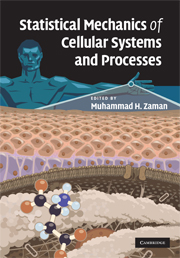Book contents
- Frontmatter
- Contents
- List of contributors
- Preface
- 1 Concentration and crowding effects on protein stability from a coarse-grained model
- 2 Observations on the mechanics of a molecular bond under force
- 3 Statistical thermodynamics of cell–matrix interactions
- 4 Potential landscape theory of cellular networks
- 5 Modeling gene regulatory networks for cell fate specification
- 6 Structural and dynamical properties of cellular and regulatory networks
- 7 Statistical mechanics of the immune response to vaccines
- Index
- Plate section
5 - Modeling gene regulatory networks for cell fate specification
Published online by Cambridge University Press: 04 September 2009
- Frontmatter
- Contents
- List of contributors
- Preface
- 1 Concentration and crowding effects on protein stability from a coarse-grained model
- 2 Observations on the mechanics of a molecular bond under force
- 3 Statistical thermodynamics of cell–matrix interactions
- 4 Potential landscape theory of cellular networks
- 5 Modeling gene regulatory networks for cell fate specification
- 6 Structural and dynamical properties of cellular and regulatory networks
- 7 Statistical mechanics of the immune response to vaccines
- Index
- Plate section
Summary
Introduction
Many cellular systems exist in more than one state. Two of the simplest and best-characterized examples are bacteriophage λ, which can be in the lytic or lysogenic state (Ptashne, 1992), and the lac operon of Escherichia coli bacteria which can be in either an active state, in which lactose is metabolized, or a repressed state, in which it is not (Novick & Weiner, 1957; Ozbudak et al., 2004). These states can be remarkably stable. For example, in the absence of signals which induce the lytic cell fate, the likelihood of any given cell infected with phage λ switching from the lysogenic state is about 10−7 per generation (Aurell et al., 2002). In multicellular organisms, a progenitor cell often selects between terminal cell fates which are even more stable; under natural circumstances, these decisions are irreversible. One complex but relatively well-studied example is the development of the cells of the immune system from a hematopoietic stem cell. The process of lineage commitment in this case involves a hierarchy of binary cell fate decisions in which a cell moves progressively closer to adopting certain terminal cell fates and loses access to others (Orkin, 2000; Medina & Singh, 2005).
Within an organism, almost all cells are genetically identical, but those in different states express different sets of proteins in order to perform specific functions. Which proteins a cell expresses is largely determined by the expression of transcription factors that regulate corresponding genes.
Information
- Type
- Chapter
- Information
- Statistical Mechanics of Cellular Systems and Processes , pp. 121 - 154Publisher: Cambridge University PressPrint publication year: 2009
Accessibility standard: Unknown
Why this information is here
This section outlines the accessibility features of this content - including support for screen readers, full keyboard navigation and high-contrast display options. This may not be relevant for you.Accessibility Information
- 4
- Cited by
